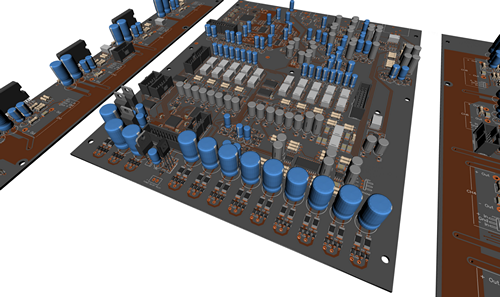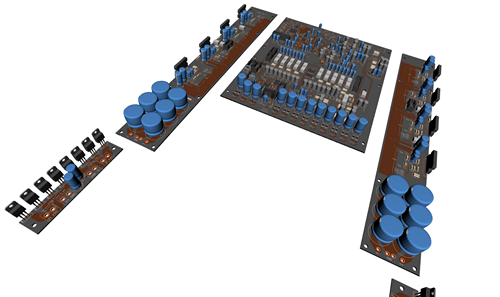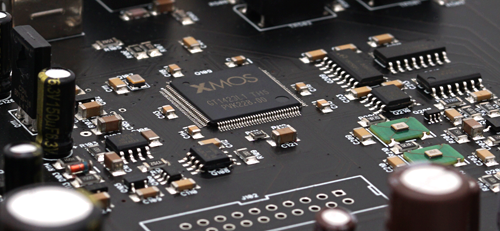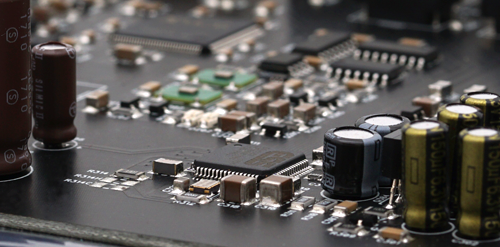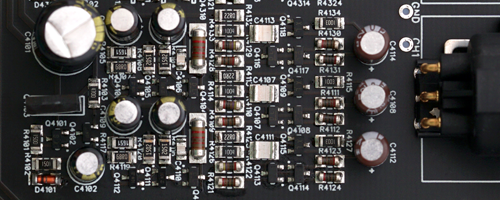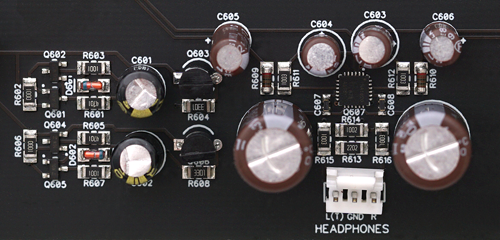Story of Asta
Quote from Pedja on 24 December 2020, 10:17 PMAsta turned into the longest awaited Audial DAC, but it did come a long way. And there was prehistory.
I started dealing with multichannel ESS based DAC about a decade ago, with the project I developed for another company. That work spanned two years of planning and more than one year of actual designing. It never turned into a commercial release though, maybe just because it was commercially too ambitious, but in terms of engineering, I'm nevertheless proud about it. Considering its complexity at one, and devotion to the details on the other side, I am sure there are not many projects, if any, that can compete with such a design.
Apart from the eight-channel DAC, and a high-quality stereo ADC with microphone input as well, it also included the eight-channel line preamplifier (with transformers coupled inputs), and an eight-channel balanced power amplifier. The power amplifier took two additional boards at each side of the main board. A stereo headphones amplifier was also included. All that was accompanied by a graphic display on the front side.
With all these features, it was still a genuine audiophile approach, with no compromises.
Overall, there is no much to remind those days though (apart from the project documentation, of course), but this simulated 3D view can give a more clear idea about what it was.
(Click on the image to enlarge it.)
Asta turned into the longest awaited Audial DAC, but it did come a long way. And there was prehistory.
I started dealing with multichannel ESS based DAC about a decade ago, with the project I developed for another company. That work spanned two years of planning and more than one year of actual designing. It never turned into a commercial release though, maybe just because it was commercially too ambitious, but in terms of engineering, I'm nevertheless proud about it. Considering its complexity at one, and devotion to the details on the other side, I am sure there are not many projects, if any, that can compete with such a design.
Apart from the eight-channel DAC, and a high-quality stereo ADC with microphone input as well, it also included the eight-channel line preamplifier (with transformers coupled inputs), and an eight-channel balanced power amplifier. The power amplifier took two additional boards at each side of the main board. A stereo headphones amplifier was also included. All that was accompanied by a graphic display on the front side.
With all these features, it was still a genuine audiophile approach, with no compromises.
Overall, there is no much to remind those days though (apart from the project documentation, of course), but this simulated 3D view can give a more clear idea about what it was.
(Click on the image to enlarge it.)
Quote from Berny on 25 December 2020, 8:51 PMI also see yet another nice diy project: a multi-channel power-amp :-). If l'm not mistaken, you also evolved through different regulated power supplies in the past and see here you came back to a more traditional approach?
Is this an LM4780 used as a balanced amplifier?
Thanks for sharing this!
I also see yet another nice diy project: a multi-channel power-amp :-). If l'm not mistaken, you also evolved through different regulated power supplies in the past and see here you came back to a more traditional approach?
Is this an LM4780 used as a balanced amplifier?
Thanks for sharing this!
Quote from Pedja on 26 December 2020, 5:28 PMTo both your questions the answer is: yes, you have a good eye.
However, and although I do plan to accompany this DAC with adequate amplification, I generally have no plans for DIY amplifiers. In foreseeable future, a DIY will remain limited to the occasional releases in the digital area.
To both your questions the answer is: yes, you have a good eye.
However, and although I do plan to accompany this DAC with adequate amplification, I generally have no plans for DIY amplifiers. In foreseeable future, a DIY will remain limited to the occasional releases in the digital area.
Quote from Pedja on 27 December 2020, 7:54 PMSo, the above project was quite exhausting, and for some time I just had to take some rest, and put away designs like this.
But some time later (or was it "soon"?), I really wanted to come with "my own" multichannel unit. "My own" meaning it would be Audial's release, where all the decisions would be mine. And more realistic. So, taking into account an eight-channel operation, it had to be only a DAC. Which then may be integrated further into the system, with all the imaginable features.
Still, it was a long shot. I continued to consider different solutions in many areas, and I’ve been changing the plans, the options, and the details many times.
However, and even though the supply, the output stage solutions, layout, and parts selection evolved all the time, the core of the hardware remained the same: it was the XMOS based USB stage and ES9018 D/A chip.
You will notice also the clocking system associated with the XMOS asynchronous USB stage, and it is quite similar to the ones you will find inside the S4 and AYA 4. The USB stage firmware is, of course, somewhat different.
So, the above project was quite exhausting, and for some time I just had to take some rest, and put away designs like this.
But some time later (or was it "soon"?), I really wanted to come with "my own" multichannel unit. "My own" meaning it would be Audial's release, where all the decisions would be mine. And more realistic. So, taking into account an eight-channel operation, it had to be only a DAC. Which then may be integrated further into the system, with all the imaginable features.
Still, it was a long shot. I continued to consider different solutions in many areas, and I’ve been changing the plans, the options, and the details many times.
However, and even though the supply, the output stage solutions, layout, and parts selection evolved all the time, the core of the hardware remained the same: it was the XMOS based USB stage and ES9018 D/A chip.
You will notice also the clocking system associated with the XMOS asynchronous USB stage, and it is quite similar to the ones you will find inside the S4 and AYA 4. The USB stage firmware is, of course, somewhat different.
Quote from Pedja on 31 December 2020, 5:02 PMNow, about the output stage.
ES9018 has a quite decent voltage output, and for the sake of simplicity, I settled on using it this way in the project shown in the first two posts. I intended to do the same in this project too, but about a year ago, and this was one of the last decisions (i.e. changes) I made here, I settled on designing for a more regular line output level. The ES9018 voltage output is just slightly above 1 V RMS, and just a bit too low to work with some amplifiers.
So, the I/V was needed. The I/V used here is a transimpedance stage with no global feedback, and it is similar to the one used in the D-09 DAC. The circuit itself is a "single end", so two are used for each channel, to manage a balanced signal. The balanced output normally brings a somewhat lower overall THD figure, by effectively canceling even order distortion components.
The I/V stage output is buffered by a bipolar / JFET hybrid circuit, which is a revamp of the White cathode follower. XLR and RCA outputs are buffered separately, so there are three buffers per channel, two for XLR and one for RCA.
The old school audiophiles remarkably don't like surface mount devices, but, apart from the metal film resistors at non-critical positions, what you see there (please click on the picture to see details you want to see) are mostly exactly the old school audiophile parts, packed into the SMT: carbon resistors, polyphenylene sulfide capacitors, and Toshiba famed low noise audio bipolar transistors and JFETs.
The picture shows one channel, and Asta of course has eight such channels.
Now, about the output stage.
ES9018 has a quite decent voltage output, and for the sake of simplicity, I settled on using it this way in the project shown in the first two posts. I intended to do the same in this project too, but about a year ago, and this was one of the last decisions (i.e. changes) I made here, I settled on designing for a more regular line output level. The ES9018 voltage output is just slightly above 1 V RMS, and just a bit too low to work with some amplifiers.
So, the I/V was needed. The I/V used here is a transimpedance stage with no global feedback, and it is similar to the one used in the D-09 DAC. The circuit itself is a "single end", so two are used for each channel, to manage a balanced signal. The balanced output normally brings a somewhat lower overall THD figure, by effectively canceling even order distortion components.
The I/V stage output is buffered by a bipolar / JFET hybrid circuit, which is a revamp of the White cathode follower. XLR and RCA outputs are buffered separately, so there are three buffers per channel, two for XLR and one for RCA.
The old school audiophiles remarkably don't like surface mount devices, but, apart from the metal film resistors at non-critical positions, what you see there (please click on the picture to see details you want to see) are mostly exactly the old school audiophile parts, packed into the SMT: carbon resistors, polyphenylene sulfide capacitors, and Toshiba famed low noise audio bipolar transistors and JFETs.
The picture shows one channel, and Asta of course has eight such channels.
Quote from Pedja on 8 January 2021, 2:53 PMAnother of the latest Asta design changes was about its headphone amplifier, and what I will finally come with will be based on the current Texas reference part in this domain, the INA1620.
The circuit around 1620 is relatively simple and is realized again using quality SMD parts, as much as possible. This stage has a fully separate supply, including its own secondary transformer windings, so it was designed rather as a dedicated headphone amplifier, than like a simple addition to the DAC.
The headphone output is stereo, and carries the two first channels.
It may still take some time and more real-world tests to really claim this, but this output should be able to drive any available headphones, whether low or high impedance ones.
And, just like the Asta line outputs, the headphone output includes the volume control. And before you ask, the Asta volume control utilizes the ES9018 internal feature. A bit more info about it will come somewhat later.
Another of the latest Asta design changes was about its headphone amplifier, and what I will finally come with will be based on the current Texas reference part in this domain, the INA1620.
The circuit around 1620 is relatively simple and is realized again using quality SMD parts, as much as possible. This stage has a fully separate supply, including its own secondary transformer windings, so it was designed rather as a dedicated headphone amplifier, than like a simple addition to the DAC.
The headphone output is stereo, and carries the two first channels.
It may still take some time and more real-world tests to really claim this, but this output should be able to drive any available headphones, whether low or high impedance ones.
And, just like the Asta line outputs, the headphone output includes the volume control. And before you ask, the Asta volume control utilizes the ES9018 internal feature. A bit more info about it will come somewhat later.


